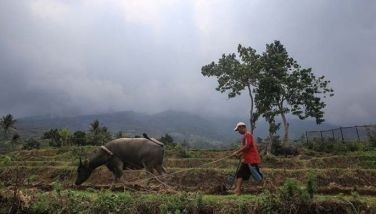International health agencies to study RP virus
October 6, 2001 | 12:00am
International health agencies will assist the Philippines in determining whether a new flu strain was responsible for downing more than 2,000 students in Metro Manila in the past weeks, the Department of Health (DOH) said yesterday.
Health Secretary Manuel Dayrit said cultured throat swab samples collected from infected students are to be sent to the World Health Organization (WHO) reference laboratory in Australia.
"We will culture the samples here but WHO will verify the strain there because they have more reagents and banks of strains. They are in a better position to determine whether or not it is a new strain," Dayrit said.
He pointed out that experts from the country’s Research Institute of Tropical Medicine will take between eight and 28 days to culture the collected samples.
The National Disaster Coordinating Council (NDCC) revealed that at least 2,212 students from Catholic schools in Metro Manila were reported to have flu-like symptoms since September, but dismissed the possibility of a bioterrorist attack.
At the same time, the DOH assured the public that the apparent outbreak of influenza is nothing to be worried about but still could not explain why only some schools were affected.
Dayrit explained that there are three types of influenza strains, including the H1N1 virus believed to have recently infected Metro Manila students.
National Epidemiology Center head Dr. Concepcion Roces noted that there is more than one type of H1N1 flu virus.
"WHO will tag and name the virus or determine if there is a new type of virus now circulating in the Philippine environment," Roces said.
Dayrit said they are also coordinating with the Center for Disease Control in the US in order to respond appropriately to the flu outbreak.
And to prevent the further spread of the virus, the DOH is working closely with local health and school officials in Metro Manila.
"Disease surveillance is being strengthened," Dayrit said.
He reminded the public to stay vigilant in monitoring diseases, to remain calm and to seek consultation for any unusual symptoms experienced.
Schools and communities were also advised to immediately report possible outbreaks to the health department.
Meanwhile, President Arroyo visited yesterday St. Paul College in Pasig City, one of the schools whose students were affected by the influenza virus.
The President, accompanied by Dayrit, inspected the school clinic and conferred with school management on the condition of the students.
In her remarks, Mrs. Arroyo said she went to the school primarily to stress to families and students that there is no cause for alarm.
Dayrit also briefed management, led by Sister Bernadette Racadio, SPC, on measures the DOH has taken to prevent the spread of the virus.
St. Paul, which reported the largest number of students exhibiting flu-like symptoms, suspended classes for four days. Their students will return to school Monday.
Health Secretary Manuel Dayrit said cultured throat swab samples collected from infected students are to be sent to the World Health Organization (WHO) reference laboratory in Australia.
"We will culture the samples here but WHO will verify the strain there because they have more reagents and banks of strains. They are in a better position to determine whether or not it is a new strain," Dayrit said.
He pointed out that experts from the country’s Research Institute of Tropical Medicine will take between eight and 28 days to culture the collected samples.
The National Disaster Coordinating Council (NDCC) revealed that at least 2,212 students from Catholic schools in Metro Manila were reported to have flu-like symptoms since September, but dismissed the possibility of a bioterrorist attack.
At the same time, the DOH assured the public that the apparent outbreak of influenza is nothing to be worried about but still could not explain why only some schools were affected.
Dayrit explained that there are three types of influenza strains, including the H1N1 virus believed to have recently infected Metro Manila students.
National Epidemiology Center head Dr. Concepcion Roces noted that there is more than one type of H1N1 flu virus.
"WHO will tag and name the virus or determine if there is a new type of virus now circulating in the Philippine environment," Roces said.
Dayrit said they are also coordinating with the Center for Disease Control in the US in order to respond appropriately to the flu outbreak.
And to prevent the further spread of the virus, the DOH is working closely with local health and school officials in Metro Manila.
"Disease surveillance is being strengthened," Dayrit said.
He reminded the public to stay vigilant in monitoring diseases, to remain calm and to seek consultation for any unusual symptoms experienced.
Schools and communities were also advised to immediately report possible outbreaks to the health department.
Meanwhile, President Arroyo visited yesterday St. Paul College in Pasig City, one of the schools whose students were affected by the influenza virus.
The President, accompanied by Dayrit, inspected the school clinic and conferred with school management on the condition of the students.
In her remarks, Mrs. Arroyo said she went to the school primarily to stress to families and students that there is no cause for alarm.
Dayrit also briefed management, led by Sister Bernadette Racadio, SPC, on measures the DOH has taken to prevent the spread of the virus.
St. Paul, which reported the largest number of students exhibiting flu-like symptoms, suspended classes for four days. Their students will return to school Monday.
BrandSpace Articles
<
>
- Latest
- Trending
Trending
Latest
Trending
Latest
Recommended




























